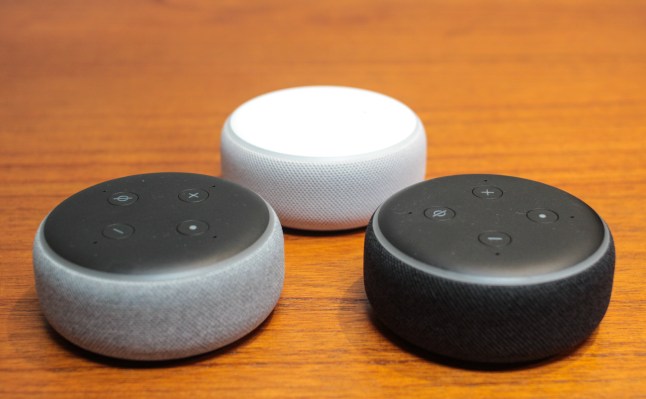Amazon had a record-breaking holiday quarter, with revenue of $72.4 billion and profits of $3 billion, but it’s not making much money off its top-selling item, the Alexa-powered Echo Dot. While the e-commerce giant said the device was its 2018 holidays best seller across all products, it also reminded investors on yesterday’s earnings call that Echo devices aren’t priced “to make money.”
Instead, Amazon sees Echos as another means of connecting with its customer base — its most avid, engaged customers, that is.
“There are a group of customers who use our devices and then we monetize that in different ways — commitment to Amazon and the video and everything else,” noted Amazon CFO Brian Olsavsky, speaking to investors on Thursday.
While some reports have dismissed Echo devices’ potential for online shopping, Amazon appears to be playing the long game with regard to voice computing. With an Echo in the home, consumers are more likely to remain a Prime subscriber, streaming Prime music or audiobooks or — on its devices with a screen — watching Prime Video. As Amazon advances its e-commerce strategy with Whole Foods and Prime Now, it also sees Echo as a means of getting items to your door within an hour or two, simply by way of voice commands.
That means, for now, Amazon’s goal is to get an Echo into the home — even if it has to sell the gadgets at cost (or even less).
And the devices are selling. Amazon said the Echo Dot was the best-selling item across all of Amazon globally during the holiday quarter, and customers purchased “millions more devices from the Echo family” in 2018 than they did in 2017.
Amazon had also said last month that more than 100 million Alexa devices had been sold to date, including the Echo Dot and other Echo-branded devices, along with those from third-parties.
As the company is usually cagey about sharing exact numbers when it comes to things like this, it was a notable milestone.
Google, of course, quickly responded with a note that its Assistant AI will be on a billion devices by the end of January. But it wasn’t a fair comparison, because Google was counting Android smartphones while Amazon’s number, we confirmed at the time, didn’t include smartphones — even though you can use Alexa from within the Alexa mobile app and even within the widely installed Amazon shopping app.
However, Echo devices aren’t Amazon’s only means of introducing Alexa to consumers.
The Echo Dot is the best seller in terms of Alexa-powered devices, due to its low price point and regular discounts during major shopping events like the 2018 holidays, Black Friday and Amazon’s own Prime Day, but it’s joined by a growing number of other Alexa products.
In 2018, the company saw more than 100 new products with Alexa built-in launched from third-party manufacturers, bringing the total up to more than 150. And Alexa works with more than 28,000 devices, like smart home devices and other hardware, from across 4,500 brands.
Amazon, itself, is trying to figure out how to put Alexa into more things. It even jokes about this in its latest TV commercial, set to be aired during the Super Bowl.
The ad references a more offbeat device — the AmazonBasics Alexa-powered microwave — but then makes cracks about the Alexa devices that didn’t work — like an Alexa dog collar and hot tub, for example.
Alexa skills top 80,000
The growing Alex ecosystem means the number of things you can do using the voice assistant, by way of its voice apps called “skills,” is also increasing.
A new number Amazon shared yesterday was that the number of voice applications built for Alexa had now topped 80,000 worldwide. That’s up from the 70,000 skills Amazon was touting back in December.
Amazon CEO Jeff Bezos mentioned this figure and other milestones related to Alexa’s improvements in a statement, on Thursday.
“The number of research scientists working on Alexa has more than doubled in the past year, and the results of the team’s hard work are clear. In 2018, we improved Alexa’s ability to understand requests and answer questions by more than 20 percent through advances in machine learning, we added billions of facts making Alexa more knowledgeable than ever, developers doubled the number of Alexa skills to over 80,000, and customers spoke to Alexa tens of billions more times in 2018 compared to 2017,” Bezos said.
The company said in November it now has more than 10,000 employees working on Alexa, as a point of reference. But it’s challenged in building up a knowledge base of questions and answers — something Google has worked on since the launch of its Knowledge Graph in 2012.
At the end of the day, consumers may not pick a device only because of what facts it can spout off, but rather because of how well it fits into the home in other ways. Alexa can play your music and share the news like any voice assistant, but it also works with other Amazon devices, like Ring doorbells and Amazon security cameras, keyless entry systems and more. And it can deliver your food and other items.
Google, meanwhile, doesn’t have a successful e-commerce business and just lost a key partner for its Google Express shopping service, with Walmart’s exit from the platform.
That leaves Google at something of a disadvantage as assistants cater more to our needs to not just answer questions or turn on the lights, but to make anything appear at our door. If Amazon has to give away a few million devices to stake out its place in the future of shopping, it believes that’s money worth losing.
